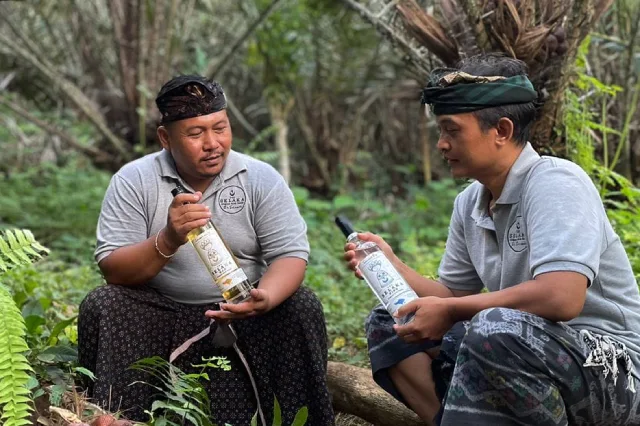Things to Do in Bali
Sunbeam Snake in Bali – The Iridescent Beauty
The Sunbeam Snake (Xenopeltis unicolor) is a non-venomous species known for its unique iridescent scales, which reflect a rainbow of colors under sunlight. Found in various parts of Southeast Asia, including Bali, these snakes are primarily nocturnal and subterranean, often burrowing in loose soil or leaf litter. Their smooth, shiny scales and dark brown or black color make them one of the most visually striking snakes in the region.
Sunbeam Snakes are typically found in forested areas, rice paddies, and near water bodies where the soil is loose enough for them to burrow. Despite their intimidating appearance, they are harmless to humans and play a vital role in controlling the population of small mammals, amphibians, and other reptiles. These snakes are mostly active at night, making daytime encounters rare. They are oviparous, laying eggs in concealed, humid locations. While they are generally elusive, their unique beauty makes any sighting a memorable experience.
According to Ron Lilley, Bali’s snake expert, this snake might have been introduced to Bali not so long ago while it now finds its niche in the ecosystem.
Sunbeam Snake
- Latin Name: Xenopeltis unicolor
- Bahasa Name: Ular Pelangi
- Length: Up to 1 meter
- Danger Level: Harmless. Non-venomous and not aggressive.
- Color: Dark brown or black with iridescent scales.
- Specific Markers: Smooth, shiny scales that reflect rainbow colors.
- Habitat: Forested areas, rice paddies, and near water bodies.
- Activity: Nocturnal (night active) and subterranean.
- Prevalence: Occasionally found.
- Region: Lowland areas and foothills.
- Encounter Risk: Low. Encounters are rare due to their nocturnal and subterranean habits.

Source: Wikimedia Commons
Conservation Status of the Sunbeam Snake (Xenopeltis unicolor)
Not Evaluated (NE) by IUCN globally. Locally, it is common in Southeast Asia, including Bali.
What Travelers want to know about Snakes in Bali
Yes, Bali is home to several dangerous snakes, including the King Cobra, Blue Krait, and Malayan Pit Viper. While these snakes are venomous, they are generally shy and avoid human contact, encounters with tourists are very very rare.
The Pythons can also be dangerous, depending ion their size and whether they feel threatened. It's important to be cautious, especially in rural and forested areas.
It is uncommon, but not impossible, to find snakes in Bali villas. Most villas are well-maintained and have measures in place to prevent wildlife from entering and gardeners keep the gardens free of potential habitats as much as possible. However, occasional sightings of non-venomous snakes like the Common Wolf Snake may occur, particularly in areas close to nature.
Snakes can be found in Ubud due to its lush, natural environment, but they are not commonly encountered by visitors. The area’s forests and rice fields provide habitats for various snake species.</p]
The most common snakes in Bali include the Common Wolf Snake and the Oriental Rat Snake. These non-venomous snakes are frequently found in gardens, forests, and near human settlements.
Bali hosts several venomous snakes, including the King Cobra, Blue Krait, Malayan Pit Viper, Javan Spitting Cobra, Green Tree Pit Viper, Island Pit Viper, Asian Coral Snake, Red-Necked Keelback Snake, Yellow-Bellied Sea Snake, and the Banded Sea Krait. These snakes possess potent venom but are typically shy and avoid human contact.
Yes, there are. Venomous sea snakes in Bali include the Yellow-bellied Sea Snake and the Banded Sea Krait. These snakes are usually found in coastal waters and are generally not aggressive towards humans.
Yes, there are non-venomous snakes in Bali. Non-venomous snakes include the Burmese Python, Reticulated Python, Common Wolf Snake, Oriental Rat Snake, Brahminy Blind Snake, Green Cat Snake, Red-tailed Pipe Snake, and the Chinese Rat Snake. These snakes are harmless to humans and play a vital role in controlling pest populations.
Identifying snakes in Bali can be challenging due to the variety of species. Yes, identifying snakes in Bali involves looking at key markers such as color patterns, head shape, and habitat. For detailed information, refer to our specific snake pages guides available on our website.
Yes. The King Cobra in Bali is known for its impressive size and potent venom. It is typically found in forests and rural areas. Despite its fearsome reputation, it tends to avoid human contact.
The Banded Krait is a venomous snake found in Bali, recognized by its distinctive black and yellow bands. It is generally nocturnal and prefers wetland habitats.</p]
The thin green snake in Bali is likely the (mostly) harmless Vine Snake or the Green Tree Pit Viper or the Island Pit Viper,, which is the snake that causes the most bites in Bali and is specifically found in the Lesser Sunda Islands of Indonesia, including Bali, Lombok, Sumbawa, and Komodo.
The striped snake in Bali could be the Blue Krait or the Banded Krait, both of which have distinct banding patterns and are venomous. These snakes are nocturnal and typically found in rural areas.
The likelihood of seeing a snake in Bali depends on your location and activities. While urban and tourist areas have fewer sightings, rural and forested areas have higher chances of encounters. However, snakes generally avoid human contact.
Besides snakes, other dangerous animals in Bali include certain species of spiders and scorpions. However, encounters with these creatures are rare, and they generally avoid human contact, and are not very venomous. It's more dangerous playing with a monkey in the Monkey Forest.
A key difference is how the toxins enter the body: venomous animals, like most snakes, inject toxins through a bite or sting, while poisonous animals release toxins when touched or ingested. The terms are often confused, and many people incorrectly call most snakes "poisonous" when they are actually "venomous".
List of Snakes in Bali
10 most common venomous Snakes in Bali
- King Cobra (Ophiophagus hannah)
- Blue Krait / Malayan Krait (Bungarus caeruleus)
- Banded Krait (Bungarus fasciatus)
- Malayan Pit Viper (Calloselasma rhodostoma)
- Javan Spitting Cobra (Naja sputatrix)
- Green Tree Pit Viper (Trimeresurus albolabris)
- Island Pit Viper (Trimeresurus insularis)
- Asian Coral Snake (Calliophis intestinalis)
- Red-Necked Keelback Snake (Rhabdophis subminiatus)
- Vine Snake (Ahaetulla prasina)
Venomous Sea Snakes around Bali
Common Non-Venomous Snakes in Bali
- Oriental Rat Snake (Ptyas mucosa)
- Common Wolf Snake (Lycodon capucinus)
- Brahminy Blind Snake (Indotyphlops braminus)
- Green Cat Snake (Boiga cyanea)
- Red-tailed Pipe Snake (Cylindrophis ruffus)
- Chinese Rat Snake (Ptyas korros)
- Bronzeback Snake (Dendrelaphis pictus)
- Sunbeam Snake (Xenopeltis unicolor)






















